Boston Marathon 2018 Race Report Part 2: What it was like to run in 38-degree rain and 25 mph headwinds
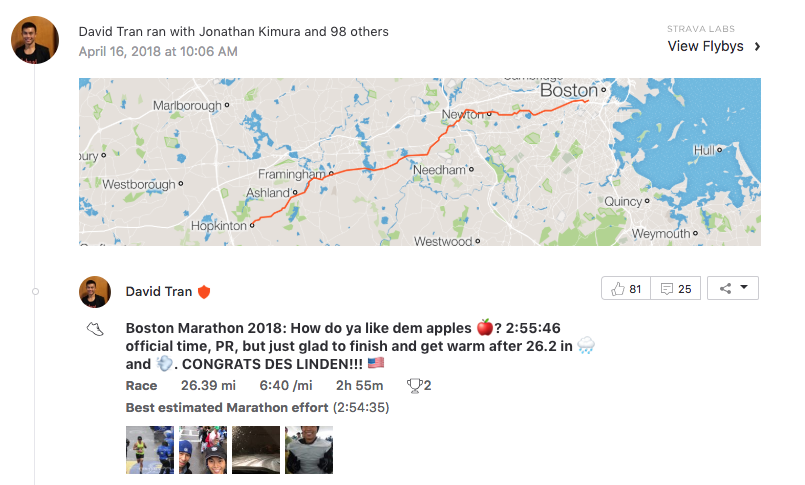
If it's not on Strava, did you even run in the rain and wind?
I previously wrote down some thoughts about running 2017 miles in 2017, but this is my first ever attempt at a race report. I was definitely riding off the adrenaline high from running my first Boston Marathon and needed a few d̶a̶y̶s̶ weeks to really fully process and reflect on the journey. Okay, I won’t lie— I was waiting for MarathonFoto to discount the race photos because I missed the pre-race sale and the Asian part of me didn’t want to pay full price for the race photos. But I digress. I wanted to share my experience and hope this can be helpful for someone who’s looking for running inspiration, hoping to qualify for Boston, planning to run the Boston Marathon, or planning to run another bad-weather race in the future. I also wrote about how Boston became a dream, and then a goal for me.
Accept what’s out of your control
In the days leading up to the Boston Marathon, I started checking the weather forecast obsessively. 76% chance of rain. 65% chance of rain— there’s HOPE! 85% chance of rain, 99% chance of rain. F*CK!

99% chance of rain and scary-looking headwinds courtesy of Dark Sky
The essence of this sport is that we push ourselves to the limits, and Boston’s weather certainly seemed like it would do just that on top of the challenge of running 26.2 miles as fast as you can. I’m not a religious person, but I found the Serenity prayer recently, and it really resonated for running, love, and life in the days leading up to the marathon, as well as during the marathon itself:
God, grant me the serenity to accept the things I cannot change,
Courage to change the things I can,
And wisdom to know the difference.
-“Serenity Prayer”, Reinhold Niebuhr (1892-1971)
Once you accept what’s out of your control: what training you did or didn’t do or the weather conditions, and focus on what you can control—your gear, nutrition, mental state, and pacing, a sense of calm overtakes you. I focused less on the negative—how unlucky I was to have run my first Boston in some of the worst conditions in its 122-year storied history, and focused on how fortunate I was to get the chance to toe the line at Hopkinton feeling good about my training. That made all the difference.
Lots of my running friends who were running Boston had set goals and were mostly throwing them out the window with the weather report. I tried to go into the race with a “let’s see” approach. I kind of had 2:52 as a goal in the back of my head, and had boosted my confidence with a solid training block including running 1:21:17 at the Oakland Half Marathon three weeks prior.
The Morning of the Boston Marathon
3:40am. My Garmin buzzed. I hadn’t slept much, but I never sleep that well the night before races anyway, so I wasn’t going to worry about that. I think sleeping well two nights before is more important anyway. I looked out the window of my friends’ place in Worcester and saw nothing but white on the ground. Snow? Really? Great. Just greaaaat. And yet, without missing a beat, I got out of bed and ambled downstairs to make some oatmeal for the bus later. On second thought, I’m pretty hungry right now, and it’ll be another 3 hours before I’m on the bus. So I finished the first bowl of oatmeal and made another one for the bus.

Ground was definitely covered in snow at 4am
I originally had planned to take a 7am train to Framingham, then bus (turns out they weren’t running) or Uber to the start line in Hopkinton. But with the bad weather, I really wanted to be able to check a bag in Boston: dry clothes at the finish line and not having to run with my phone seemed like a good tradeoff for losing sleep. I also kind of wanted the full experience of seeing all the runners at Boston Common and riding the bus from Boston to Hopkinton. When I got in my friend Kevin’s car at 4am and saw all the snow on the road, I briefly thought about dropping out and going back to bed. But before I knew it, he had dropped me off at Union Station, then I was on the commuter rail, where I spotted one other runner clutching his Boston Marathon clear plastic bag. I convinced myself that no matter what, this would be a race to remember.
After we got off the bus, my Excelsior Running Club teammates and I walked over to the second tent in the Athlete’s Village. As soon as I stepped on the muddy slush that was the field on which the tent sat, I was very happy with my decision to keep my racing shoes in a bag and wear an old pair of shoes that I planned to donate, along with sweatpants, a pullover and old snow gloves. Many other runners had planned similarly with clothes they planned to shed before the start or sometime during the race, ponchos, plastic bags to cover their shoes, space blankets, picnic blankets, and in some cases, sleeping bags. I’m amazed by all the inventions and creativity that runners in the village came up with to stay warm or dry, no matter how fruitless the endeavor eventually proved to be. I’m amazed even more so by how adaptable our minds, spirits and bodies are. We ask our bodies to endure 26.2 miles, and after months of training, they are willing and able. Huddling in the Athlete’s Village tent with thousands of other shivering, wet and cold runners who all chose to do so, I was amazed by how upbeat most of the runners were. We were all looking forward to it in an almost sadistic way. Several times I heard runners make the funny and light remark: “The faster you run, the less time you have to spend out in the rain, so just make sure to run fast!”
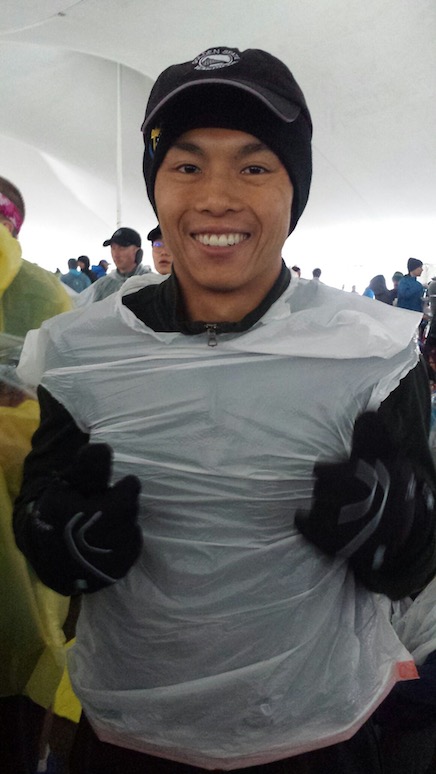
I had planned and practiced a certain nutrition strategy for years, then decided to make a last-minute change based on feel/instinct/guesswork. Maybe most people don’t do that, but I rolled the dice this time because I happened to do a bunch of reading the week before about optimal calorie intake for runners of different abilities and speeds. I had pretty much always had oatmeal before races and had been practicing that for years, so I knew that was tried and true. For my previous seven marathons, I had consumed a gu before (when I remembered to) and one every 5 or 6 miles, but I went into Boston planning to change it up. That’s pretty risky, but the last-minute calculation seemed right in my head. It was cold, so my body and muscles were working double-time to both keep up the pace as well as prevent me from freezing, so I adjusted to planning to have a gu every THREE miles instead of every five. That felt like a big, big change, but thinking back there have definitely been races where after three or four miles between gus, my body was starting to look for calories. You don’t want to get to that point. Having a gu every three miles, it felt like I was preempting that. I think it paid off in a big way. I also made the decision to run the marathon in the new Nike Vaporfly 4%s the week of the marathon— they felt great during two test runs, so I made a decision on Thursday the week before and didn’t look back. Huge thanks to Andrew for letting me run in his pair of Vaporflys since mine hadn’t arrived yet!
Toeing the Line at Hopkinton
The beginning felt very, very surreal. “Last call for Wave 1!” I had taken my time putting on my shoes, reluctantly shedding the snow gloves, but I still had my sweatpants and pullover on. I started walking towards the start line. It felt rather anti-climatic—after all that, here I was just walking up to the start line at my own leisurely pace. There wasn’t a gun— I just chose when to cross and that’d be the start of my Boston Marathon journey. I kept my sweatpants and pullover on for as long as I possibly could, then when I was within a few feet of the start line, I took a deep breath, and raised my head to look at the dark clouds. I could hear Tony Robbin’s voice from a recent Personal Power tape I had listened to, so I cocked my head up again and forced myself to crack a smile. I took another deep breath, and just like that, my toes crossed the start line, and my Boston Marathon had begun.
My first thought was that the winds didn’t seem so bad— living in San Francisco and hating treadmills, I had done plenty of running in the rain, so it was mainly the wind that I was worried about. I had planned to go out pretty conservatively, but the first mile was pretty downhill, and I started behind some slower runners, so I found myself playing Frogger, trying to get to the sides to pass people while also avoiding stepping in any big puddles. I saw some other runners doing the same and tried to follow the paths they carved out. At the end of mile 1, I felt like I had taken it super easy and spent most of my energy trying to safely pass people, and yet my watch showed that 6:37 had elapsed for the first mile, not that far off my race-day goal pace of 6:30-6:35 before finding out about the rain and wind.
So after a mile, I decided to try to hold that pace for the next few miles and take stock again. By mile 2 or 3, trying to avoid puddles had become a fruitless exercise and I was pretty soaked through and through. For most of the rest of the race, I honestly didn’t really pay too much attention to how hard it was raining. I definitely remember some breaks in the rain, and definitely some parts where it rained more or less, but for the most part, it kind of all blurred together. I remember the sudden gusts of headwind for sure, but I think the winds mostly calmed down or were tempered both literally and figuratively by the amazing crowds who still made it out to cheer runners on, as well as other runners. I tried my best to never be completely exposed as a single runner, always speeding up a bit to latch onto a pack or at least behind and around other runners. Mostly, I just tried to smile as much as I could and take everything in.

Managing the Middle Miles
Around mile 11, my first minor crisis happened: I really needed to pee. A few thoughts went through my head: since it was already raining and I was already soaked, if I just peed my shorts, nobody would notice, and it’d all get washed away anyway, right? But I definitely had never trained for peeing without breaking stride. The next thought I had was whether I could just hold it for another 15 miles. That was at least another hour forty, so that probably was a no go. More than the time lost to making a bathroom stop, I was definitely afraid of stopping and just having my muscles seize up or just not being able to get back on rhythm. Right after we passed the 12-mile marker, I saw four porta-potties. Unfortunately all of them were occupied, and I didn’t want to wait in case all four runners ended up being in there a while. But right as I was running past the second porta-potty, I saw the handle flip from red to green, the door fly open, and a runner pop out, so I jumped in, managed to take off my gloves with barely functioning hands, use the restroom, and then pop back out 40-45 seconds later. I recognized some runners that I had passed earlier in the race, and feeling much lighter, took off to try to make up for lost time. In my head, part of me was saying that I could run a 6:00 mile to make up for the bathroom break and still come out around a 6:40 for the twelfth mile, but after speeding up for just a little bit, a wiser voice prevailed, and I slowed back down to my previous pace, clocking the twelfth mile in at 7:20 including the bathroom break.
Around this time, I started feeling a dull, but very constant pain on the top of in my right foot that I hadn’t really experienced before. I reasoned that it was probably a combination of the new shoes (I had only run about 12 miles on the Vaporflys) and also tying them tighter than usual because I really didn’t want to have to deal with my shoelaces coming undone and either tripping in the rain or having to stop to re-tie them. I thought many times about stopping to re-tie them, but between my hands barely functioning enough to take my gloves off to open my gus and put them back on, and the likelihood that even if I re-tied them, the pain wouldn’t go away, I decided to just keep running and try not to think about it. The probability that it would lead to a serious injury seemed relatively low, and I figured the freezing rain would probably numb the pain anyway. I stopped thinking about the foot for the most part, and it didn’t really bother me the rest of the way.
At the halfway point, I saw my split was terribly off my pace: 1:29, on pace for a 2:58, about six minutes behind my original goal of 2:52. I took solace in the fact that I hopefully wouldn’t have to make a bathroom stop in the second half, and that despite the conditions, I still had a good shot of PR-ing— that is, breaking my previous personal best of 2:57:46. It was a mixed bag of both encouraging and discouraging, kind of like a compliment-shit sandwich. I thought back to some of the lessons that Tony Robbins talked about— managing your state and creating state changes. On one hand, I was behind my goal, soaking wet and freezing, with 13 miles to go and Boston nowhere in sight. On the other hand, here I was with the opportunity to run the Boston Marathon, halfway to running sub-three at one of the Marathon majors. I had trained for years to get to this point, I wasn’t going to get any wetter than I already was, so I might as well enjoy it. Several times throughout the remainder of the race, I actually tried the Tony Robbins exercises where I looked up and forced myself to smile, and this may have been the endorphins, or the cold cutting off oxygen to my brain, but I actually *felt* happier.
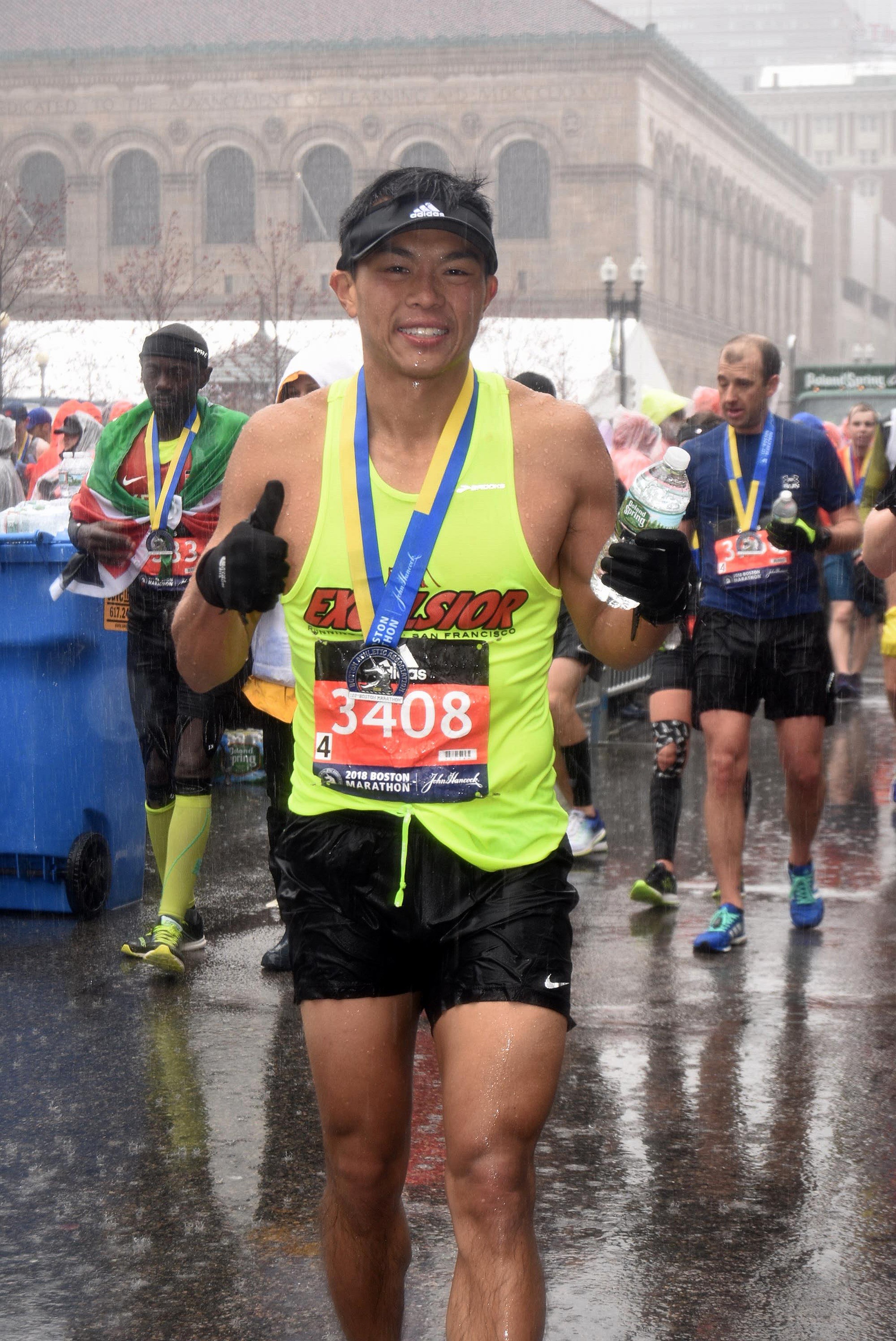
Sorry Heartbreak Hill, but I left my heart in San Francisco
I remember reading that the Wellesley cheer tunnel was somewhere around the halfway point, so I knew to look forward to it, and also to not speed up too much from the energy. Their energy was indeed amazing, but I made sure to stay within my pace zone. Some of the towns in between Wellesley and Boston also brought amazing energy, but everything blurred together so much that I can’t remember anything super specifically. When I got to mile 16, I knew the first of four hills concluding with the infamous Heartbreak Hill were coming up. On the third hill, I felt a tap on the shoulder— I turned around and saw my friend Cesar. We gave each other some words of encouragement: “These hills aren’t that bad!”. I told him “We got this!” and took off to take on Heartbreak Hill. Seeing a familiar face and knowing the last big hill was just ahead gave me an extra boost of energy and motivation.
Once I reached the top of Heartbreak Hill and saw the sign “You are now leaving Heartbreak Hill”, another jolt of energy shot through me. This was it— I had conquered Heartbreak. Sorry Heartbreak, but I left my heart in San Francisco. Running all those hills in SF had prepared me well. I knew it was mostly downhill from here— usually when you hear that expression, it’s a negative, but for runners, there’s no more welcome sight. The cheers of the energetic crowds the last few miles, along with the rush from passing runners led to some really fast miles from 23-25: 6:18, 6:18, 6:18. All of a sudden, I was turning left on Boylston. I again looked up towards the sky, cracked a big smile, and raced towards the finish line.
See you in 2019, Boston!
Other great race reports I enjoyed
- Greg Kroleski’s race report, or how a 2:42 marathoner ended up finishing Boston 2nd DFL in 8:09:48: Spoiler alert: it involves a medical tent. Huge, huge props to Greg for getting back out and finishing.
- Julian Davis (/u/Warm_Harbor)’s /r/running race report on Reddit
- Stefan Ljungberg’s race report on his blog
- Joy Ebertz’s race report on Medium
- Matthew Futterman’s race report in the New York Times
Huge thanks to:
- Andrew, Chikara, and the rest of the Excelsior running club for all the training and racing advice as well as the “scenic cooldowns”
- Everyone that I’ve had the privilege of sharing miles with over the last few years
- Kevin, Kelly and Bowser for being amazing hosts for the weekend
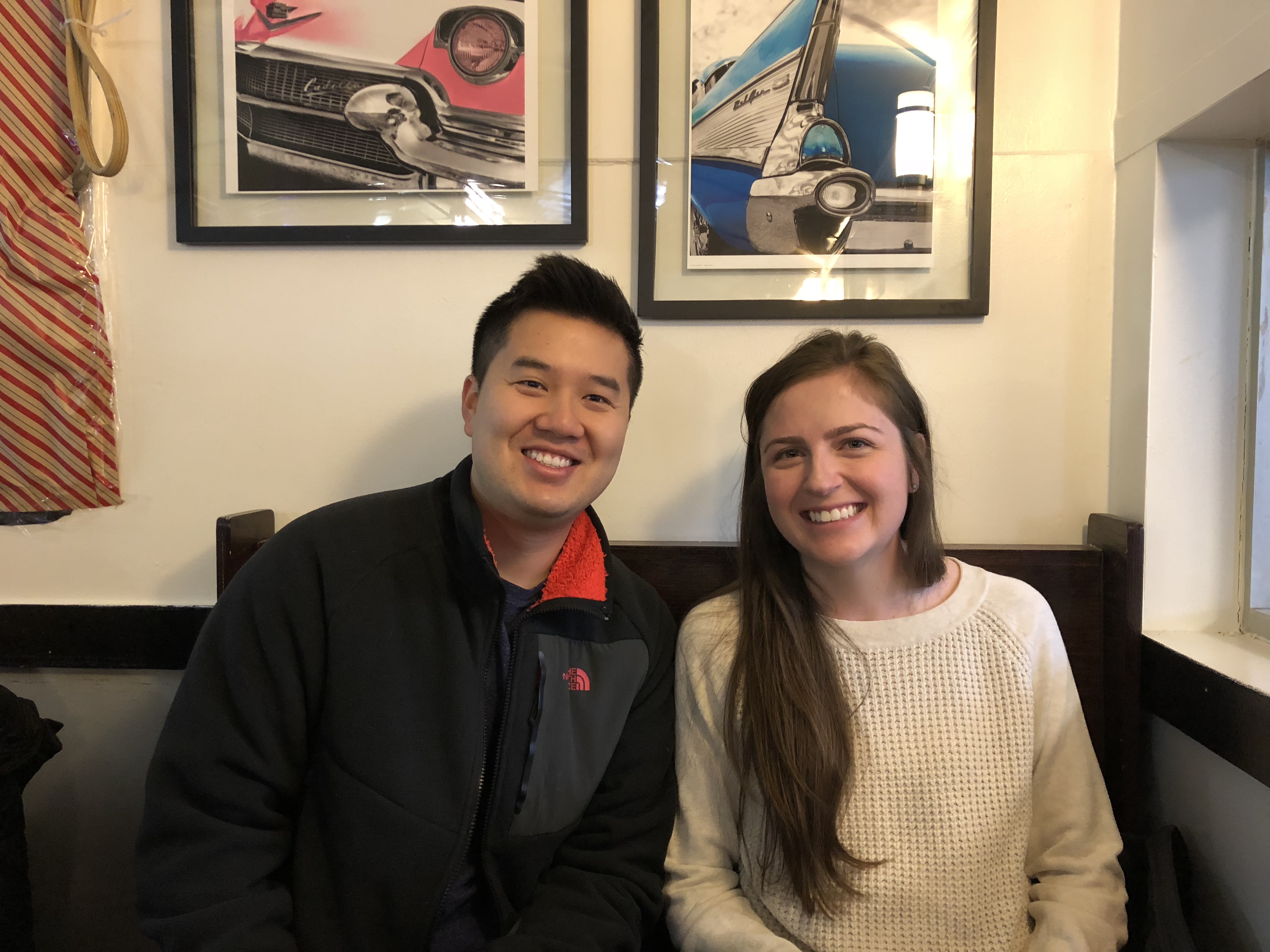
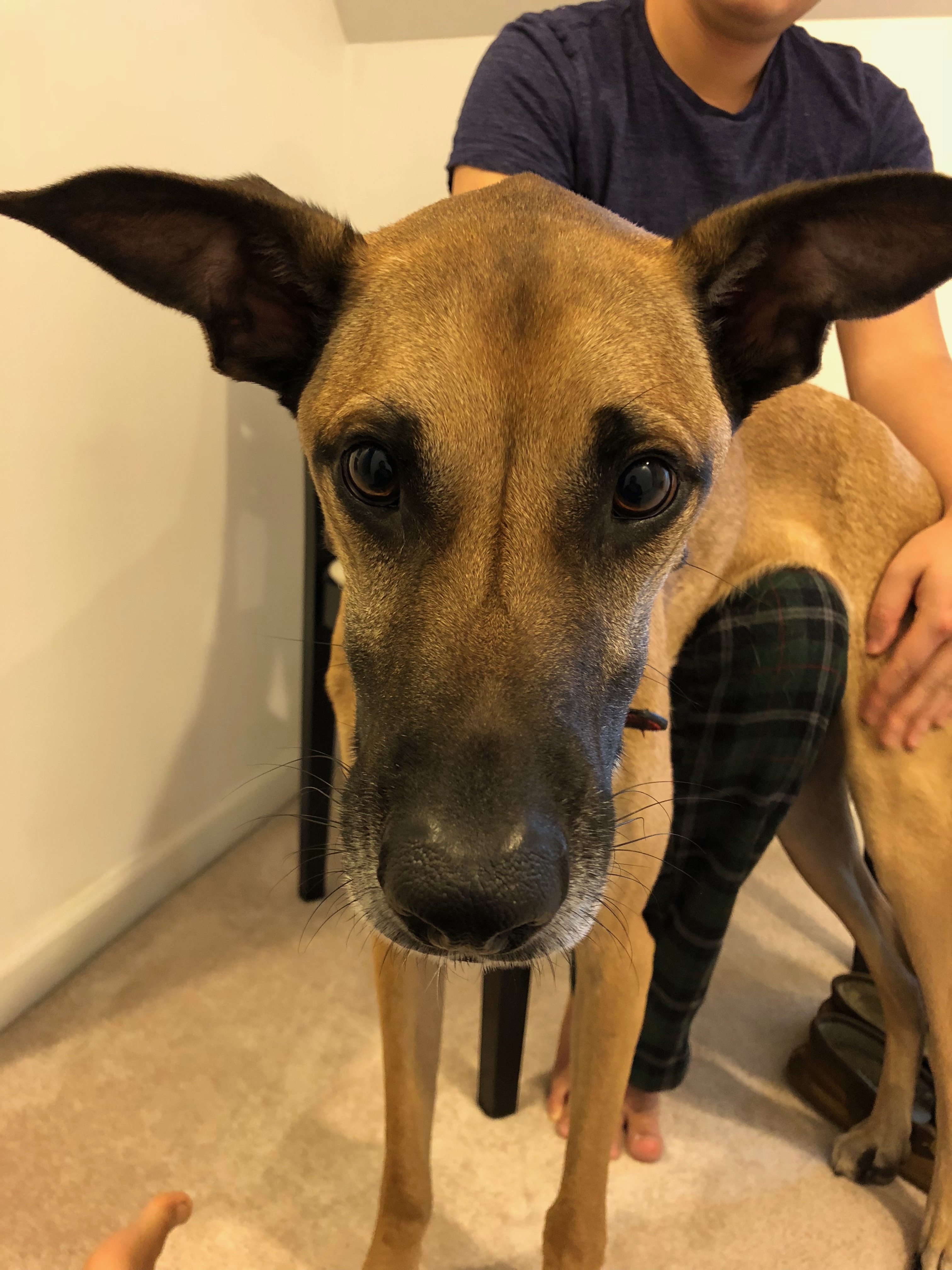
My amazing hosts for the weekend: Kelly and Kevin, and of course, Bowser!
If you enjoyed this, please share on Twitter,head over to Medium and applaud it!, or join the discussion on Reddit!
Thanks for reading!
If you enjoyed this post, check out my latest post: Burnout and Basketball Dynasties:
An exploration of burnout, personal growth, and how lessons from the Golden State Warriors dynasty relate to long-term goals in life.
Read more →
Or subscribe to get notified of new posts: